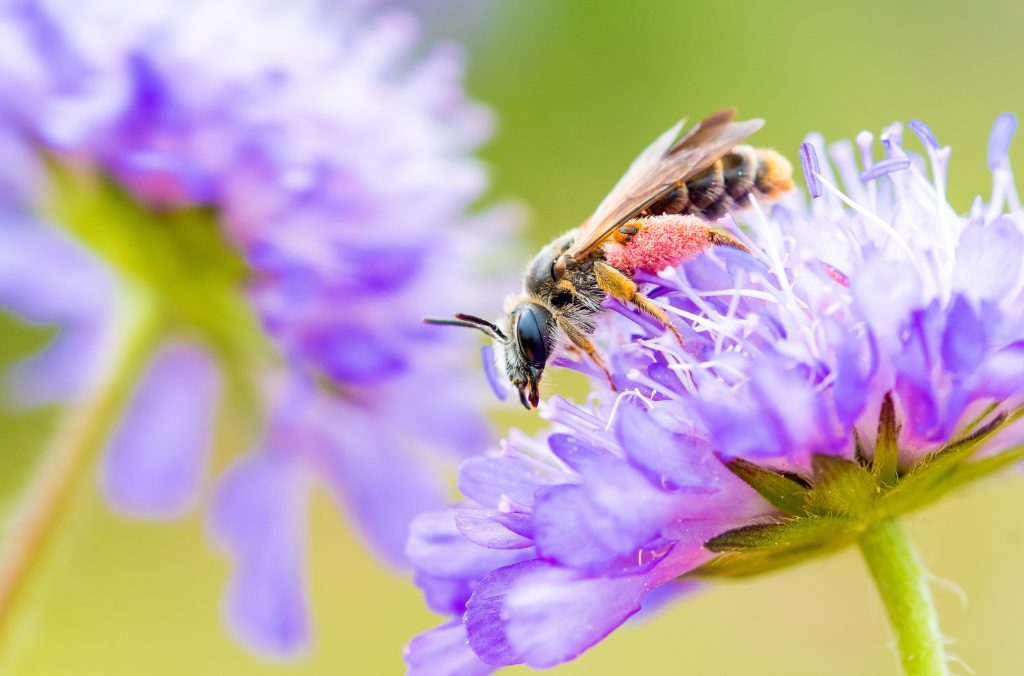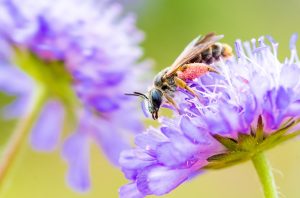
…blog by Laura Larkin, Buglife North Cornwall B-Lines Conservation Officer, written for Solitary Bee Week 2023
I’m sure you can imagine a winter’s day on the North Cornwall coast. It’s reasonably mild, but there is a strong wind which seems to be a permanent fixture, and a light mizzle which can easily last for days at a time. I spent a lot of this most wonderful of seasons in 2022/23 with a small army of fantastic volunteers, walking across numerous fields, tools in hand, planting out thousands upon thousands of Field Scabious (Knautia arvensis) plants.
This is admittedly a very specific task to be undertaking, but there’s a very good reason for our efforts. We’ve been out to help one very special solitary bee – the Large Scabious Mining Bee (Andrena hattorfiana).

At around the size of a honeybee, the Large Scabious Mining Bee is Britain’s largest mining bee, it is Nationally Scarce, and in Cornwall is only known from four areas along the north coast where the populations are very fragmented. A handful of these populations are doing very well, but some are surviving on just a handful of scattered flowers, and if anything were to happen to those, they would struggle to survive much longer.
The flight period of this solitary bee from mid-June until early-August coincides with the flowering season of our Field Scabious plants – in Cornwall, this is the only plant that the bee will take pollen from. The female bees collect the pollen to take back to provision their nests, as a food source for their young. This activity is more interesting than it might sound because Field Scabious pollen happens to be bright pink, and having the opportunity to watch these bees flying around from flower to flower with large pink balls of pollen attached to their hind legs is something that never ceases to make me smile.

Large Scabious Mining Bees can only fly about 900m from where they nest, making it vital that Field Scabious plants are in good supply within this radius to help sustain the often-fragile bee populations. The plants flower from June until September and grow best in calcareous soils. In Cornwall, our soil is generally fairly acidic, although the exception to this is around some of the amazing sand dune systems of the north coast such as those at The Towans, Penhale and Rock. The sandier soils found around these locations create ideal conditions for Field Scabious, but they will not grow at all in much of the county.
Because they flower later in the season, Field Scabious plants can potentially struggle, even in places that are managed as wildflower-rich grassland. If the sites are cut or grazed too early in the year, the Field Scabious won’t have a chance to set seed and reproduce, and the sudden removal of its only pollen source can be devastating for the already struggling populations of the Large Scabious Mining Bee.
This is where our North Cornwall B-Lines project has come in. We have worked very closely with local entomologist Paddy Saunders who has been working with this bee species for many years. We worked to identify sites which were near known Large Scabious Mining Bee populations, but had no or very limited Field Scabious. Upon mentioning the plight of this solitary bee to numerous local landowners, quite a few wanted to help, signed up to be a part of our project, and were willing to ensure that these beautiful flowers remain uncut until at least the autumn each year.

On beautiful sunny days in summer 2021 we spent many hours in glorious coastal, flower-filled fields, hand harvesting Field Scabious seed – carefully removing the seedheads from their tall stems and storing them in paper bags as we went. These seeds were then dried and separated from their seed heads before being stored away for the winter. In spring 2022 we worked with some local nurseries who grew these seeds on into plants for us. Because the seed was in quite short supply, there simply wouldn’t have been enough local seed to have made any impact if we had sown it without growing the plants first.
In summer 2022, Paddy was out undertaking surveys for North Cornwall B-Lines, looking for some of Cornwall’s most threatened bee species and helping us to confirm that our work was going to make the best impact it could. We were absolutely delighted when he managed to find two new populations of the Large Scabious Mining Bee, one site was a new record which we were delighted about, and on the other site, the bee hadn’t been seen in nearly 40 years. Because of these new records, we were able to tweak our conservation work, adding additional sites to our list and planting out the Field Scabious plants to act as stepping-stones – linking some of the known bee populations together and helping to safeguard them for the future.

After spending nearly a year being pampered and cared for in the nurseries, we are back to winter 2022, and planting out almost 9,000 Field Scabious plants with local volunteers. We simply wouldn’t have been able to do this work without them and I remain incredibly grateful for their support.
These 9,000 plants have been planted across multiple new sites, and many of them should flower for the first time in 2023. At the time of writing, there are still a few weeks to go until we would expect to see the flowers, but I am very excited to get the first glimpse at what numerous people have worked so hard for, to help to safeguard this solitary bee in Cornwall. Spending time working to help conserve a particular bee species as part of this larger project has been incredibly rewarding, and I also have to keep reminding myself that this year is just the beginning, and that these plants should continue to grow and spread, and that we will continue to see the benefits of this work for years to come.
Join us & celebrate the wonderful world of solitary bees!
90% of bee species are solitary bees and along with other pollinating animals their hard work is responsible for at least one in every three mouthfuls we eat. However, like many species, they are under threat and need our help.
We invite you to Earn Your Stripes by pledging to help the bees, Wear Your Stripes for a day, or the entire week, and Share Your Stripes by helping us to raise awareness and share your activities, solitary bee facts and photos across your socials this Solitary Bee Week
Find us on
Facebook, Twitter & Instagram
Tag us and share your solitary bee journey using the hashtags #SolitaryBeeWeek | #WearYourStripes | #ShareYourStripes | #EarnYourStripes
Join in with our monthly #SolitaryBeeHour on the 1st day of every month at 1:00pm on Twitter; be sure to tag us @SolitaryBeeWeek and use the hashtag




